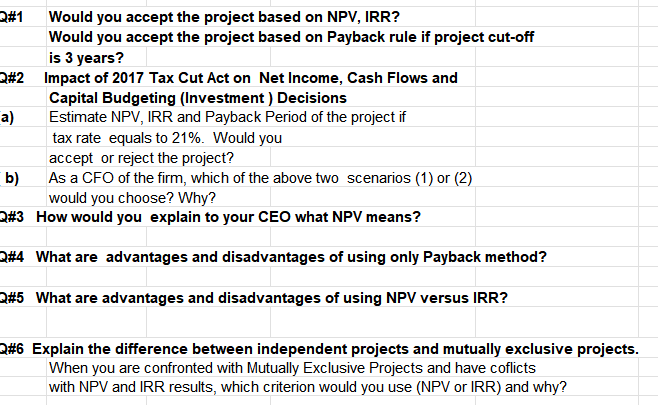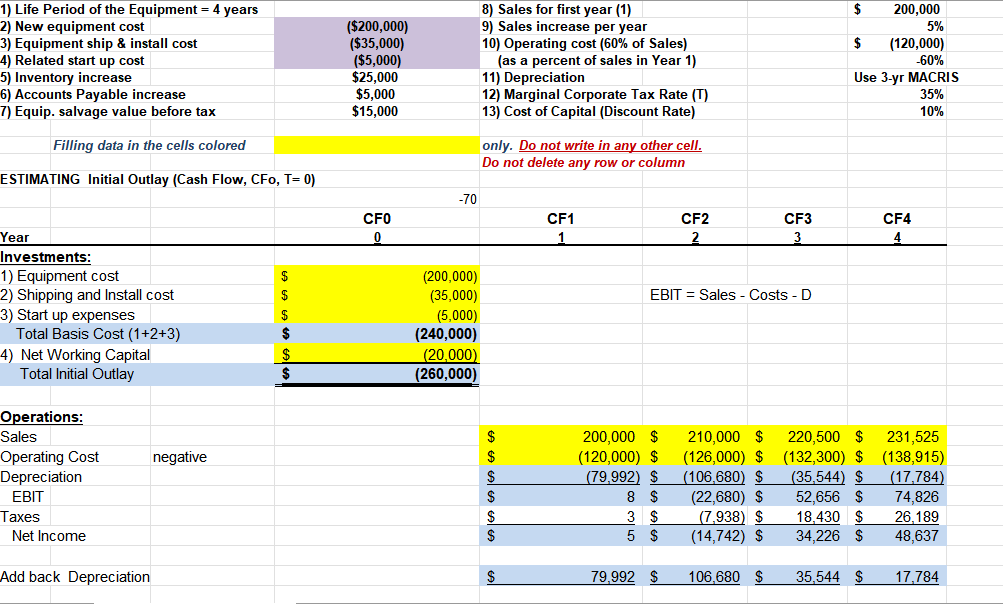

 Please answer the questions based off the information
Please answer the questions based off the information
Q#1 Would you accept the project based on NPV, IRR? Would you accept the project based on Payback rule if project cut-off is 3 years? Q#2 Impact of 2017 Tax Cut Act on Net Income, Cash Flows and Capital Budgeting (Investment ) Decisions a) Estimate NPV, IRR and Payback Period of the project if tax rate equals to 21%. Would you accept or reject the project? b) As a CFO of the firm, which of the above two scenarios (1) or (2) would you choose? Why? Q#3 How would you explain to your CEO what NPV means? Q#4 What are advantages and disadvantages of using only Payback method? Q#5 What are advantages and disadvantages of using NPV versus IRR? Q#6 Explain the difference between independent projects and mutually exclusive projects. When you are confronted with Mutually Exclusive Projects and have coflicts with NPV and IRR results, which criterion would you use (NPV or IRR) and why? 1) Life Period of the Equipment = 4 years 2) New equipment cost 3) Equipment ship & install cost 4) Related start up cost 5) Inventory increase 6) Accounts Payable increase 7) Equip. salvage value before tax ($200,000) ($35,000) ($5,000) $25,000 $5,000 $15,000 8) Sales for first year (1) 9) Sales increase per year 10) Operating cost (60% of Sales) (as a percent of sales in Year 1) 11) Depreciation 12) Marginal Corporate Tax Rate (T) 13) Cost of Capital (Discount Rate) $ 200,000 5% $ (120,000) -60% Use 3-yr MACRIS 35% 10% Filling data in the cells colored only. Do not write in any other cell. Do not delete any row or column ESTIMATING Initial Outlay (Cash Flow, CFO, T=0) -70 CFO CF1 1 CF2 2 CF3 3 CF4 4 0 $ $ EBIT = Sales - Costs - D Year Investments: 1) Equipment cost 2) Shipping and Install cost 3) Start up expenses Total Basis Cost (1+2+3) 4) Net Working Capital Total Initial Outlay $ $ (200,000) (35,000) (5,000) (240,000) (20,000) (260,000) $ $ negative Operations: Sales Operating Cost Depreciation EBIT Taxes Net Income $ $ $ $ $ $ 200,000 $ (120,000) $ (79.992) $ 8 $ 3 $ 5 $ 210,000 $ (126,000) $ (106,680) $ (22,680) $ (7.938) $ (14,742) $ 220,500 $ (132,300) $ (35,544) $ 52,656 $ 18,430 $ 34,226 $ 231,525 (138,915) (17,784) 74,826 26,189 48,637 Add back Depreciation $ 79,992 $ 106,680 $ 35,544 $ 17,784 Total Operating Cash Flow $ 79,997 $ 91,938 $ 69,770 $ 66,421 $ Terminal values: 1) Change in net WC 2) Salvage value (after tax) Total $ $ 20,000 9,750 29,750 Project Net Cash Flows $ (260,000) $ 79,997 $ 91,938 $ 69,770 $ 96,171 NPV = $6,812.10 IRR = 11.1871% Payback= 3.19 Profitability Index = 1.03 Discounted Payback = 3.90


 Please answer the questions based off the information
Please answer the questions based off the information 





